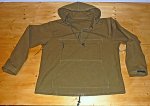N
Nomad
Guest
To be honest, I'm not terribly keen on hoods, so this would just be for occasional use (and for style purposes when I want to be an outdoor poser).
Did the finishing touches today...

Added the Velcro bits at cuffs and hood. Did bar tacks at the top and bottom of the pit zips, at the top corners of the kangaroo pocket, and the top and bottom of the hand holes in the lower pocket. Tidied up the drawcords, and used thin bankline for the zip pulls (with figure-8 knots). It all seems to work - in particular, the zips run nicely. I'll be wearing it to and from work in the coming days to try and get the newness out of it.
The changes I made from the standard pattern were...
It's easily the most complex thing I've sewn so far, although I wouldn't say any of it was especially difficult. It was more a case of taking things slowly, and thinking through each step in preparation for the actual sewing. The planning and checking certainly took up much more time than each bit of sewing. The collar was quite tricky because the edge that joins to the garment curves inwards and outwards, and dealing with the sleeve easing took a while because I was trying to make sense of something in the pattern or sewing directions that ultimately doesn't seem to be right. Doing zips was new to me, and I could probably do with a bit more practice, but it was good to get a few under my belt because they've always been a bit daunting. If anything, the real challenge was in taking a series of relatively straightforward sewing steps and stringing them all together to come up with a garment, and the pattern was a huge help in this. Having now been through it, I feel much more confident about making other things based on the same pattern, like a wool shirt and maybe a zip-front jacket in similar cotton to this (ie, an army-type field jacket without the camo).
It weighs 700g, which, for the area of fabric used, works out at 7oz highly windproof cotton. Total cost of material and notions was around £25.
Things I learned...
Needless to say, even if some of the stitching is less than perfect, I'm well pleased with the result.
Did the finishing touches today...

Added the Velcro bits at cuffs and hood. Did bar tacks at the top and bottom of the pit zips, at the top corners of the kangaroo pocket, and the top and bottom of the hand holes in the lower pocket. Tidied up the drawcords, and used thin bankline for the zip pulls (with figure-8 knots). It all seems to work - in particular, the zips run nicely. I'll be wearing it to and from work in the coming days to try and get the newness out of it.
The changes I made from the standard pattern were...
- Collared version with zip-on hood.
- Changed pockets to kanagaroo with zip and full-width handwarmer.
- Added pit zips.
- Velcro tabs on cuffs.
- Velcro volume reducer on hood.
- Drawcords on hood and hem.
- Adjusted sleeve profile to remove easing at sleeve caps.
It's easily the most complex thing I've sewn so far, although I wouldn't say any of it was especially difficult. It was more a case of taking things slowly, and thinking through each step in preparation for the actual sewing. The planning and checking certainly took up much more time than each bit of sewing. The collar was quite tricky because the edge that joins to the garment curves inwards and outwards, and dealing with the sleeve easing took a while because I was trying to make sense of something in the pattern or sewing directions that ultimately doesn't seem to be right. Doing zips was new to me, and I could probably do with a bit more practice, but it was good to get a few under my belt because they've always been a bit daunting. If anything, the real challenge was in taking a series of relatively straightforward sewing steps and stringing them all together to come up with a garment, and the pattern was a huge help in this. Having now been through it, I feel much more confident about making other things based on the same pattern, like a wool shirt and maybe a zip-front jacket in similar cotton to this (ie, an army-type field jacket without the camo).
It weighs 700g, which, for the area of fabric used, works out at 7oz highly windproof cotton. Total cost of material and notions was around £25.
Things I learned...
- Making your own clothing isn't so scary.
- It pays to be methodical.
- Don't trust everything the pattern says.
- It takes much more thread than I reckoned at first.
Needless to say, even if some of the stitching is less than perfect, I'm well pleased with the result.
